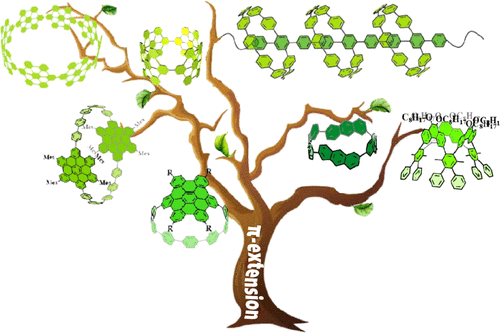当前位置:
X-MOL 学术
›
Acc. Chem. Res.
›
论文详情
Our official English website, www.x-mol.net, welcomes your
feedback! (Note: you will need to create a separate account there.)
Large π-Extended and Curved Carbon Nanorings as Carbon Nanotube Segments
Accounts of Chemical Research ( IF 16.4 ) Pub Date : 2021-10-29 , DOI: 10.1021/acs.accounts.1c00505 Jinyi Wang 1 , Xinyu Zhang 1 , Hongxing Jia 1 , Shengda Wang 1 , Pingwu Du 1
Accounts of Chemical Research ( IF 16.4 ) Pub Date : 2021-10-29 , DOI: 10.1021/acs.accounts.1c00505 Jinyi Wang 1 , Xinyu Zhang 1 , Hongxing Jia 1 , Shengda Wang 1 , Pingwu Du 1
Affiliation

|
Designing and synthesizing topologically unique molecules is a long-term challenge for synthetic chemists. Classical polycyclic aromatic hydrocarbons (PAHs) are a large group of π-conjugated planar organic compounds with rich photophysical and electronic properties, while nonplanar/curved PAHs have different molecular orbital arrangements and demonstrate unique properties. The chemistry of curved aromatic molecules has been of significant interest to explore the relationship between π conjugation and molecular geometry, which offers an attractive combination of fundamental problems, potential applications, and aesthetic appeal. Remarkable advances have been made in the last few decades during the discovery of novel curved aromatic molecules, including corannulenes, fullerenes, and carbon nanotubes (CNTs). Especially, there has been increasing interest in making single-chirality CNTs and their curved molecular components (known as finite segments of CNTs) with a fixed geometry. The most representative examples of such organic molecules are cycloparaphenylenes (CPPs) and related carbon nanorings, which possess cylindrical topologies and nanoscale conjugated segments similar to CNTs. CPPs, as the shortest cross-section and the simplest structure of armchair CNTs, have been synthetically accessible since 2008. Recent years have witnessed breakthroughs and rapid development in the synthesis of CPP-based nanorings as well as their derived molecules. In these molecules, the distortion from aromatic planarity can induce radially oriented π systems and further affect their electronic, optical, self-assembly, and charge-transport characteristics. These unique and interesting carbon nanorings are potentially useful in a variety of optoelectronic and biomedical materials. It is well-known that extension of the π-conjugated system facilitates the delocalization of π electrons and the redistribution of electronic clouds, leading to rich diversification of physical properties in the fields of electronics, optics, and supramolecular chemistry. Therefore, the precise design and controllable synthesis of carbon nanorings with large π conjugation will promote important advances in synthetic chemistry. To date, a number of π-extended carbon nanorings have been reported, and they exhibit novel physicochemical properties resulting from their fascinating topologies and structures. However, challenges still remain in the synthesis of π-extended carbon nanorings and their structural analogues and exploration of their unique properties.
中文翻译:

大 π 扩展和弯曲的碳纳米环作为碳纳米管段
设计和合成拓扑独特的分子是合成化学家的长期挑战。经典的多环芳烃(PAHs)是一大类π共轭平面有机化合物,具有丰富的光物理和电子特性,而非平面/弯曲的多环芳烃具有不同的分子轨道排列并表现出独特的性质。弯曲芳族分子的化学对探索 π 共轭与分子几何形状之间的关系具有重要意义,它提供了基本问题、潜在应用和美学吸引力的有吸引力的组合。在过去的几十年中,在发现新的弯曲芳香族分子(包括二环烯、富勒烯和碳纳米管 (CNT))期间取得了显着进展。尤其,人们对制造具有固定几何形状的单手性碳纳米管及其弯曲分子组件(称为碳纳米管的有限片段)越来越感兴趣。这种有机分子最具代表性的例子是环对亚苯基(CPPs)和相关的碳纳米环,它们具有圆柱形拓扑结构和类似于碳纳米管的纳米级共轭链段。CPPs 作为最短截面和最简单结构的扶手椅碳纳米管,自 2008 年开始合成。近年来,基于 CPP 的纳米环及其衍生分子的合成取得了突破和快速发展。在这些分子中,芳香族平面的畸变可以诱导径向取向的 π 系统,并进一步影响它们的电子、光学、自组装和电荷传输特性。这些独特而有趣的碳纳米环可用于各种光电和生物医学材料。众所周知,π共轭体系的扩展有利于π电子的离域和电子云的重新分布,从而导致电子、光学和超分子化学领域的物理性质多样化。因此,具有大π共轭的碳纳米环的精确设计和可控合成将促进合成化学的重要进展。迄今为止,已经报道了许多 π 延伸的碳纳米环,并且由于其迷人的拓扑结构和结构,它们表现出新的物理化学性质。然而,
更新日期:2021-11-16
中文翻译:

大 π 扩展和弯曲的碳纳米环作为碳纳米管段
设计和合成拓扑独特的分子是合成化学家的长期挑战。经典的多环芳烃(PAHs)是一大类π共轭平面有机化合物,具有丰富的光物理和电子特性,而非平面/弯曲的多环芳烃具有不同的分子轨道排列并表现出独特的性质。弯曲芳族分子的化学对探索 π 共轭与分子几何形状之间的关系具有重要意义,它提供了基本问题、潜在应用和美学吸引力的有吸引力的组合。在过去的几十年中,在发现新的弯曲芳香族分子(包括二环烯、富勒烯和碳纳米管 (CNT))期间取得了显着进展。尤其,人们对制造具有固定几何形状的单手性碳纳米管及其弯曲分子组件(称为碳纳米管的有限片段)越来越感兴趣。这种有机分子最具代表性的例子是环对亚苯基(CPPs)和相关的碳纳米环,它们具有圆柱形拓扑结构和类似于碳纳米管的纳米级共轭链段。CPPs 作为最短截面和最简单结构的扶手椅碳纳米管,自 2008 年开始合成。近年来,基于 CPP 的纳米环及其衍生分子的合成取得了突破和快速发展。在这些分子中,芳香族平面的畸变可以诱导径向取向的 π 系统,并进一步影响它们的电子、光学、自组装和电荷传输特性。这些独特而有趣的碳纳米环可用于各种光电和生物医学材料。众所周知,π共轭体系的扩展有利于π电子的离域和电子云的重新分布,从而导致电子、光学和超分子化学领域的物理性质多样化。因此,具有大π共轭的碳纳米环的精确设计和可控合成将促进合成化学的重要进展。迄今为止,已经报道了许多 π 延伸的碳纳米环,并且由于其迷人的拓扑结构和结构,它们表现出新的物理化学性质。然而,











































 京公网安备 11010802027423号
京公网安备 11010802027423号